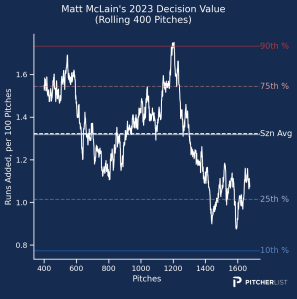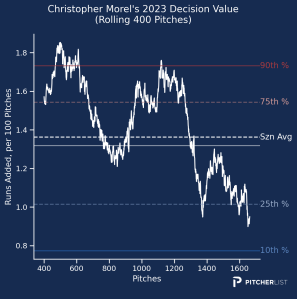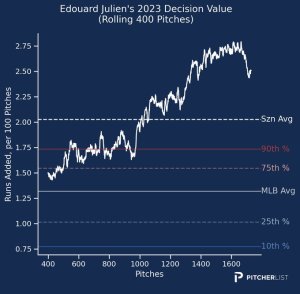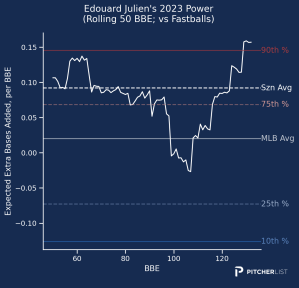Second base doesn’t feature too many superstars—in fact, as many second basemen are going in the first 200 picks in NFBC drafts as there are catchers. That said, there are a lot of young players manning the keystone in the majors right now and there could be plenty of value to be found even towards the back of your draft.
There will be a significant advantage in rostering one of the top three or four second basemen in most leagues due to how much better we project these guys to be over the rest of the crowd. Should you miss out on one of these players (as most of us will), you could even consider “punting” your second basemen in standard leagues and simply take one of the last few that are available due to the minimal separation between some of the middle to lower tiered options.
As with all of the position ranking articles, these blurbs and ranks come from my Top 300 Hitters for Fantasy Baseball 2024 piece that also debuted today! Check that piece out for more on my rankings philosophy and, well, all the rest of my rankings.
Check out the Hacks & Jacks podcast featuring Scott Chu and Joe Gallina, which also happened to be a finalist for Best Baseball Podcast of 2021 by the Fantasy Sports Writers Association (FSWA)!
I also host an AMA in the r/fantasybaseball subreddit every Friday (starting sometime in late March) starting around noon ET that lasts through the rest of the day and into the weekend, so feel free to join the fun and ask questions or make comments.
Tier 1
1. Mookie Betts (2B/SS/OF, LAD) – News that Betts will be the everyday second baseman for the Dodgers is fun because it means he’ll retain his most valuable position in all formats for at least another two seasons. The new stolen base rules didn’t help Betts get back to his pre-2020 speed totals, but a career-high 39 home runs and 233 combined runs and RBI with a .307 batting average makes the lower stolen base totals a non-issue. Betts is locked into the top of the order for the Dodgers, and his fantastic plate discipline ensures the ratios and counting stats will continue to pour in. Those in formats where you need 20 starts to gain positional eligibility won’t be able to plug Betts in as a shortstop, but that doesn’t impact his value in any way. Betts is the clear top dog at second base and also near the top in the outfield, and that’s what matters most.
Tier 2
2. Ozzie Albies (2B, ATL) – Being a fixture near the top of the lineup for Atlanta is a pretty sweet gig for fantasy. Hitting behind Acuña means there are tons of runs to drive in (and you only need to hit a single to get him in) and hitting in front of Olson means getting on base gives you a good chance to score a run. Throw in 30 home run power, double-digit stolen bases, and a position that’s light on elite talent, and you’ve got yourself a top-20 player. The batting average might be a bit up and down from year to year, but it won’t ever hurt you, making him well worth a second or third-round pick.
3. Marcus Semien (2B, TEX) – Semien has at least 700 plate appearances in every season since 2018 (except for 2020, of course) and set a career-high with 753 in 2023. We don’t always talk about plate appearances this way in fantasy, but it’s an incredibly important stat because it was 60 more plate appearances than any other second baseman in the league and 90 more than the fifth-place guy (Albies). To put that in perspective, most guys who hit between second and fourth in the order will get you around 30 plate appearances in any given week, maybe 35 if they have a lot of high-scoring games and no days off. That means Semien got an extra two weeks’ worth of stats thanks to his durability and place at the top of a strong lineup. This is especially valuable in points formats, where Semien’s contact ability combined with his volume give him an incredibly high floor. He likely won’t give us anything close to his magical 45 home run season in 2021, but with what amounts to two extra weeks of plate appearances, Semien should accumulate his way into 27-29 home runs and over 200 combined runs and RBI.
Tier 3
4. Jose Altuve (2B, HOU) – I’m not ready to say that injuries are a huge issue for Altuve, though he’s heading into his age-34 season and is coming off the most missed games in his career. On the bright side, Atluve gave us 17 home runs and 14 steals in just 90 games with a .311 batting average, which is a 30 home run, 25 stolen base pace over 162 games, and a 26 home run, 21 stolen base pace over a more realistic 140 games. The Astros should continue to be a highly competitive team in 2024, and as long as Altuve is in the lineup, he should contribute to all five categories.
5. Nico Hoerner (2B/SS, CHC) – Those in deeper formats should probably move Hoerner up within this tier as stolen bases have a higher premium in those leagues, but even in shallow leagues, you are welcome to get excited about his 43 stolen bases in 2023. Fifteen is probably the hard ceiling for home runs for the slap-hitting middle infielder, but the excellent contact ability and the ever-present green light should allow Hoerner to come close to matching his 2023 stat line in 2024.
6. Gleyber Torres (2B, NYY) – It’s difficult to foresee exactly where in the lineup the Yankees will put their most dependable player of 2023 with the addition of Soto, but the improved offense around him should mean that his counting stats will improve to at least some degree in 2024. I wouldn’t count on many more home runs (25) or stolen bases (13) this season, but if he brings the impressive improvement to his plate discipline back in 2024, it should keep those ratios high and give way to a significant boost to his runs scored and RBI.
7. Ketel Marte (2B, ARI) – Marte rebounded in a big way in basically every category we use for fantasy and now finds himself batting near the top of the order for a team that actually can score runs. 25 home runs is probably the high end of what to expect in 2024, but the 94 runs scored and 82 RBI from 2023 shouldn’t be much different from his 2024 totals. Slap a .275 or better batting average and a .350 or better OBP on it, and you’ve got a solid second baseman.
Tier 4
8. Matt McLain (2B/SS, CIN) – McLain won’t repeat his .290 batting average without a lot of batted ball luck (he’s not the type of hitter who can hit almost 25% line drives like he did in 2023), but there’s a good enough power and speed combo to give McLain a shot at 20-25 home runs and 15-20 steals for the Reds along with above-average counting stats. The decision-making and contact ability were progressing in the wrong direction, which raises some alarm bells, but to me that gets offset by the strong debut last season, at least to some degree. It’s also why I’m much lower on him than his current NFBC ADP.


9. Luis Arraez (2B, MIA) – Arraez is at his best in points leagues where you get credit for all of those singles even if they don’t drive anyone in, but 80 runs scored and 60-70 RBI with a batting average that can be anywhere from .310 to .350 has value even when it comes with no speed and only 10 home runs. Arraez isn’t a fit for every team build, though. For example, if you’ve already drafted three or four hitters who are likely to hit .280 or better, Arraez’s impact to your bottom line may not quite be worth a pick in this range. If you instead took a few guys who either will or could tank your batting average (De La Cruz or Schwarber come to mind), Arraez can move the needle significantly due to the number of plate appearances he should get every week and the fact that he’s the odds-on favorite to win the NL batting title.
10. Andrés Giménez (2B, CLE) – Like many Guardians, Giménez got off to a slow start in 2023, particularly in the power department as he hit just three home runs in his first 61 games along with way too many grounders and pop-ups. Following that skid, things did pick up as Giménez hit 12 home runs and stole 23 bases over the remaining 92 games, which would have been a 20 home run, 40 stolen pace over 162 games.
I don’t buy into Giménez hitting 20 home runs with any regularity, but 15 is a reasonable baseline, and 30-40 steals in the current environment are also repeatable thanks to his aggressive manager. There also should be improved counting stats in 2024 as he cements his role as the number two hitter in front of Ramirez and Naylor, and that will help him return more value in 2024.
11. Bryson Stott (2B, PHI) – The spray-hitting second baseman broke out in a big way in 2023 by hitting 15 home runs and stealing 31 bases with a high batting average for the Phillies. He finished as the 60th-best hitter for fantasy purposes in standard leagues, though I’m not sure he can be quite so successful in 2024. The 15 home runs seem about right, but the 31 stolen bases are more than he had in his entire career up until 2023. The new rules give players a boost, but this was a little extreme. I’m envisioning something closer to 20 steals (which is still a big jump from his previous single-season record of 14). Put that together with good ratios (.270 average with a .325 OBP, perhaps?), and you have a hitter who is definitely in the top 100 and has a shot at approaching the top 50.
12. Ha-Seong Kim (2B/3B/SS, SDP) – Another player who exceeded all reasonable expectations in 2023, Kim wound up at the top of the order and slapped his way into 17 home runs, 38 steals, and 84 runs scored. The stolen base upside is pulling him up these rankings, and his strong plate discipline should help Kim recreate something close to his .351 OBP from 2023. I’m not sure Kim can flirt with 40 steals again, but even if he only gets 30, he should be well worth this price.
The trade of Soto may have a weird effect on Kim as it will open up the top of the lineup. The Padres could move Kim to the number one or two spot as his contact-oriented approach is ideal for those roles, but San Diego is so right-handed heavy at this moment that they could also choose to use Cronenworth in that role and move Kim to fifth or sixth. Kim’s skillset is best for fantasy when he’s batting first or second, though hitting lower isn’t a bad thing for his RBI totals and he should get plenty of opportunities to run in either situation.
Tier 4
13. Thairo Estrada (2B/SS, SFG) – Despite missing over 40 games in 2023, Estrada managed to hit just as many home runs and steal a few more bases than he did in 2022 while also hitting for a better average. Estrada should again find himself at or near the top of the Giants lineup, but as it currently stands, the Giants offense will not create many run-scoring opportunities. 15 home runs and 25 steals could be there, but the counting stat totals aren’t going to be pretty unless the Giants make significant changes to the lineup and Estrada’s health risk exacerbates the counting stat issue even more.
14. Christopher Morel (2B/3B/OF, CHC) – Morel is still without a regular position due to his subpar defensive skills, but his raw power suggests he could hit 30 or more home runs in a season if he managed to make contact on a more consistent basis. Morel’s strikeout woes are well-documented, though, and his decision-making skills declined as the season went on (see below). The low contact ability means Morel needs to make good decisions at all times, and until he can pull that off, he’ll remain an extremely volatile player.

15. Zack Gelof (2B, OAK) – I was quite harsh on Gelof during the regular season due to his weird swing, his poor zone contact numbers, and his inflated line drive rates. While Gelof did improve his zone contact to an extent as the season went on, my lack of faith in players who miss more than 20% of the pitches they swing at in the zone remains as steadfast as ever.
Gelof’s mechanics aren’t enough to prove to me that he can sustain a line drive rate close to 30% as he had for most of the season in 2023, but I do admit the power is legitimate and the A’s will play him near the top of the order every single day. 20 home runs and 20 stolen bases are very much in play for Gelof (and 25 home runs wouldn’t shock me either), but the strikeout rate and luck regression will likely bring that batting average closer to .230.
16. Edouard Julien (2B, MIN) – In his very first exposure to the majors and being only 24 years old, Julien showed he is and will likely continue to be among the best decision-makers in the league (see below) and can punish fastballs.


This is an excellent starting point to launch a successful 2024 season, though it’s worth noting that there are weaknesses in how he performs in both contact and power against breakers and offspeed pitches. That particular weakness isn’t unique to Julien, though, as many young players struggle to adjust against how well major league pitchers can use these weapons compared to minor leaguers. I believe there’s room for Julien to learn how to deal with these pitches, and it could lead to 20 home runs with 90+ runs scored if he can stay at the top of the Twins’ lineup.
17. Trevor Story (2B, BOS) – I remain pretty low on Story, unfortunately, as he’s simply been unable to find any health or consistency since moving to Boston. Strikeouts continue to plague him as he’s maintained a strikeout rate of over 30% since joining the Red Sox, and while injuries may be partially to blame, I expect health will remain an issue going forward.
This ranking respects that a healthy Story could certainly hit 20 home runs and steal 25 bases in 140 games or so, but that version of Story has been fleeting of late. It’s a big-time risk-reward pick that could work out very well, but I wouldn’t make this bet unless I also intended to take a second player with second-base eligibility. For what it’s worth, this ranking would be considerably lower in draft-and-hold formats and other deeper leagues, but the replacement level in standard leagues is high enough that it can’t hurt you that much if it’s a swing and a miss.
18. Nolan Gorman (2B, STL) – The 27 home runs in 119 games isn’t that surprising for those who followed Gorman as a prospect, and neither is the 32.3% strikeout rate he’s shown in 208 career games in the majors. Gorman’s extreme contact issues make him a wildly volatile player in both real life and fantasy, especially since he’s not especially good at making contact even when he’s not chasing pitches. The Cardinals weren’t afraid to bench him against lefties and shuffle their lineup around to cover for it, and I do expect that to continue until Gorman adjusts.
19. Jorge Polanco (2B, SEA) – Polanco kept the double-digit walk rate from 2023 (though it came with an elevated strikeout rate) and also slugged an impressive 14 home runs in just 80 games, but it was a second straight season where injuries kept him out for a large chunk of the season. Polanco has 25 home run upside with decent ratios and counting stats as the presumed cleanup hitter in Seattle, but the biggest question mark is whether he can stay healthy enough to make an impact.
20. Brandon Drury (1B/2B, LAA) – So much for a power regression, eh? Drury only played in 125 games in 2023, but still managed to hit 26 home runs for the Angels as a follow-up to the 28 he hit back in 2022. I’m inclined to believe that the Drury we saw in 2022 and 2023 is the one we will get in 2024, and that means a .260 batting average, 25-27 home runs, and 150 combined runs and RBI over a full season.
Of course, Drury isn’t known for playing full seasons as he’s never played in 140 games in a season since going pro in 2010. He missed significant time in 2018, 2019, 2020, and 2021, so projecting more than 120 games is a big risk to take. That said, in shallow leagues, he remains an excellent back-end infielder who can provide power and RBI while batting in the heart of the order for a bad team.
Tier 5
21. Jonathan India (2B, CIN) – At the time of writing, Jonathan India still projects to be an everyday player for the Reds between second base and DH (with most of his time spent doing the latter), and in that role, there’s plenty of upside for India to hit over 20 home runs while stealing 15 or more bases. India has fallen short of 120 games for two straight seasons after his breakout rookie year, and the missed time has turned into waves of inconsistency. Heading into his age-27 season, India has an opportunity to once again be a part of the future of the Reds, but there’s considerable injury risk as well as an uncertain role that makes him a challenging player to rely on as we head into 2024.
22. Jeff McNeil (2B/OF, NYM) – McNeil is essentially Arraez-lite. He puts a ton of balls in play, rarely strikes out, and scores runs. He doesn’t do those things quite as well as Arraez, but McNeil does them consistently. McNeil is slightly more likely to get to double-digit home runs and steals, but 10 is pretty close to the cap for him in both categories.
23. Tommy Edman (2B/SS/OF, STL) – I was not at all in on Tommy Edman in 2023 due to his move to the bottom of the order and his historical performance in that spot, and while Edman has a clear starting role and is coming off a third straight season with at least 27 home runs, I’m still not overly excited about the other assets Edman brings to the table. Edman finished as the 130th best hitter last season according to the FanGraphs auction calculator with stolen bases being the only category where he didn’t provide negative value. I don’t see much reason to suspect anything to improve much in 2023, which makes Edman better suited to deeper roto leagues than anything else for the speed.
24. Jake Cronenworth (1B/2B, SDP) – Cronenworth could find his way back to the heart of the order with Soto now in New York, and hitting between some combination of Bogaerts, Machado, and Tatis is a good way to drive in 80 runners and score 80 runs. The batting average will likely be .240 or worse and he’s not likely to exceed 15 home runs, but Cronenworth should play enough to accumulate counting stats and be a high-floor, low-ceiling option for those in deeper formats.
25. Brandon Lowe (2B, TBR) – Lowe has the pop to hit 30 home runs, but injuries, inconsistency, and platoon splits continue to hold him back. If you’re desperate for power late in the draft, Lowe is a gamble worth considering, but at this point, it’s just a gamble.
26. Brendan Donovan (2B/OF, STL) – Remember the stuff I said about McNeil? That all applies to Donovan except for the fact that Donovan has missed almost half of 2023 with an elbow injury and also is at risk of landing on the large side of a platoon if he continues to slug under .300 against left-handed pitching. He should provide solid ratios against righties with double-digit home run power and a little bit of speed, but there’s a lot of playing time risk that comes with it.
Tier 6
27. Ryan McMahon (2B/3B, COL) – While McMahon’s 2023 seems productive on the surface, a huge amount of his production came over a 50-game hot streak over the summer where he hit .299/.388/.540 with 60 combined runs and RBI and 10 home runs. Before the streak, McMahon had a pedestrian .675 OPS, and afterward, he had a .672 OPS. That’s 50 games of good production and 102 games of sandbagging your stats. Throw in a rising strikeout rate and a horrible offense around him, and you have a player who can contribute to your counting stats when he’s at home and who should otherwise be on the wire.
28. Brendan Rodgers (2B, COL) – The third pick of the 2015 draft hasn’t quite lived up to what was expected, but his blend of hit tool and power has me coming back to the well one last time in deep drafts to see if he can put together a 17-20 home run season with a .275 batting average. It’s not impossible as he’s only 27 years old and will have every opportunity to be a key player for the Rockies, but it gets less likely by the season.
29. Jordan Westburg (2B/3B, BAL) – Westburg could hit 20 home runs in a full season in the majors with workable ratios and counting stats; however, Baltimore isn’t likely to give him that many plate appearances unless there’s an injury or trade that clears up more room on their roster. Between Henderson being the man at third and youngster Connor Norby banging on the door to the majors, it’s hard to see Westburg getting more than 120 games in 2024, but if he does, he can be a solid piece to the back end of a fantasy roster.
30. Gavin Lux (2B/OF, LAD) – Lux missed all of 2023 with a knee injury he suffered shortly before the start of the season, but returns in 2024 with the keys to the starting shortstop job. Once a top-five prospect, our expectations for Lux have fallen dramatically after 273 very average games (for fantasy purposes) to start his career. I suppose you can see 15 home runs and 10 steals if you squint a bit, but Lux’s only bankable value comes from his strong plate discipline which should lead to a .270 batting average and .350 OBP.
Photo by Brian Rothmuller/Icon Sportswire | Adapted by Justin Paradis (@JustParaDesigns on Twitter/X)
